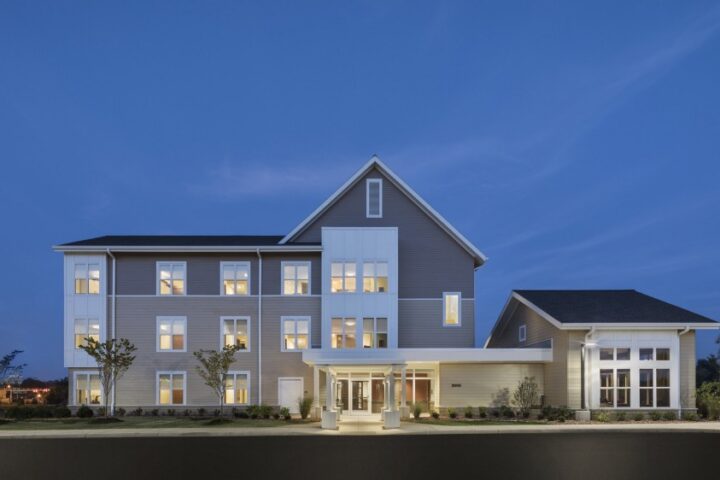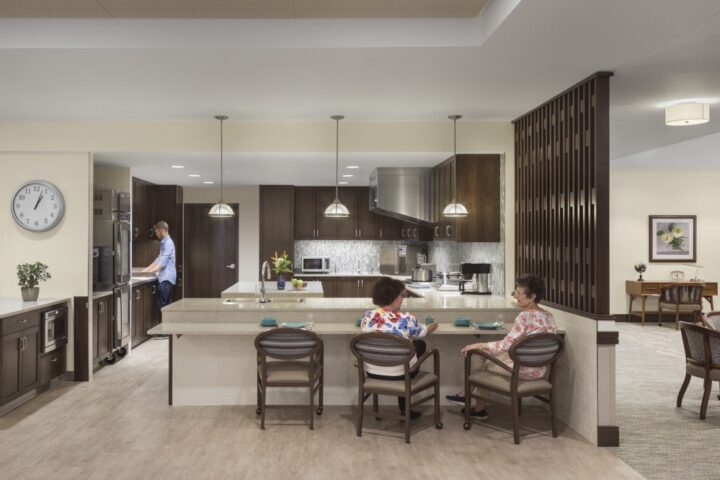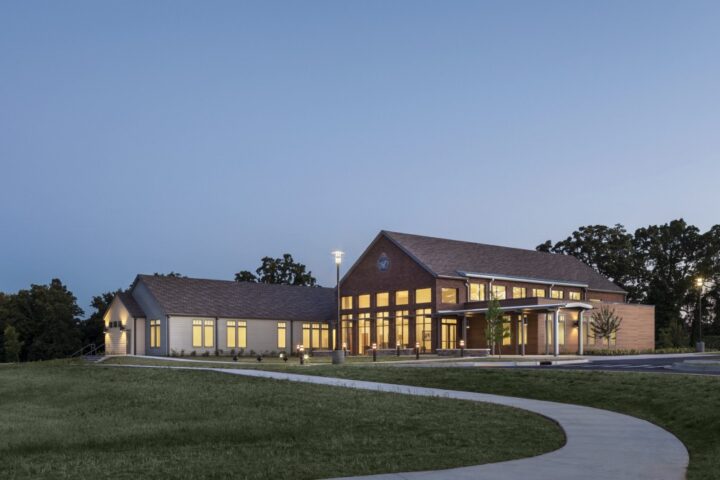
The state Veterans’ Home in North Little Rock, AK, is styled like a home rather than an institutional setting. Photograph by Sarah Mechling / Copyright Perkins Eastman
This article is an excerpt. Read the full version by Perkins Eastman Principal and Senior Living Co-Leader Martin Siefering in Seniors Housing Business via this link.
It is disgraceful that tens of thousands of Americans have died in our nursing homes, which are largely public-funded. As a society, it is up to us to learn from this moment and take steps to move beyond the warehousing of our elders. We all deserve better.
While the COVID-19 pandemic has impacted the lives of all Americans, it has had the biggest impact on those who live and work in our nursing homes. Typically older adults who have multiple chronic conditions, and those who live in nursing homes are some of the most at-risk for the coronavirus. As a society, we have housed our most fragile, vulnerable population in inhuman, badly-outdated nursing homes, primarily built in the 60s-70s and reliant on Medicaid reimbursement. And it is no surprise that these environments are also less-than-ideal for the caregivers who work there. The combination of these factors, along with inadequate preparation, has created the unfortunate circumstance where thousands of Americans are now dying in our nursing homes from complications of the coronavirus and having profound implications to our larger health care systems and to our economy at large.
“When we, as a society, see that it’s appropriate to warehouse our elders, and to put them in small spaces, to underpay their staff so that there are chronic staffing shortages — I think if we see that as an adequate treatment of our elders, then we’re going to have a bad time. We are going to see this over and over again.” – Dr. James Wright, medical director at Canterbury Rehabilitation & Healthcare Center in Richmond, VA, where over 45 people to date have died, as stated for the Washington Post on April 11, 2020.
For those who have followed the nursing home tragedies in the media, one might place the blame for the deaths on the owners who are only interested in making a profit, but it is not that simple — we all have responsibility.
“We all opted for this type of environment for our elders. And as a result, this virus spread through a publicly funded nursing home, like wildfire…. Without improvements, a publicly funded nursing home is a virus’s dream,” adds Dr. Wright.

Jewish Home: Green House in Rochester, NY. Photograph by Sarah Mechling / Copyright Perkins Eastman
Change is Possible
This is a terrible time for nursing homes — but there is reason for hope.
For years, progressive organizations have been developing and testing solutions to keep people out of nursing homes, improve the roles and compensation of caregivers, and create alternative physical environments that improve the quality of life for the nursing home residents. Not only will these solutions, which have already been trialed and tested in small numbers, positively address the quality of lives for the caregivers and those who need care, they have many of the additional qualities necessary to prevent the spread of infectious disease.
Barriers to Innovation
In order to focus on solutions, we need to understand the barriers present that prevent industry-level change.
The majority of any nursing home’s revenue comes through reimbursement from Medicaid, which is jointly funded by the federal government and individual states. Partially due to this, nursing homes have been grossly underfunded for many years — increases in their revenue streams have been continually squeezed. These increases have not kept up with the ballooning operating costs, and very little provision is made within the reimbursement stream for capital improvements — the types of money that improves or replaces facilities over longer periods of time. This has left us with badly outdated facilities that do not respond to the needs of today’s nursing home residents, and poorly compensated staff.
In these environments, staff are often treated like commodities, not paid reasonable wages, not given autonomy to act on behalf of those they care for, and not given the tools that they need to be successful; it is no wonder that staff turnover for nursing home workers is one of the highest for all professions.
Why Do People Live In Nursing Homes?
Nursing homes are often the only way for people to access their Medicaid benefits, which are most critical for those who have limited financial resources.
Those with any degree of affluence have choices: they can hire private home health aides, or can live in a retirement community or an assisted living community. But for those with very limited income, these choices are not available — they must seek Medicaid reimbursement, which is only generally available in a nursing home setting. Compound this with the underpaid staff at many traditional nursing homes and it becomes clear why our society has ignored this segment of our population for so long.
Another segment who must live in nursing homes: those who need complex, extensive, long-term nursing care 24-hours each day — services that cannot realistically or economically be provided in any other location.
These, the frailest of the frail, are the members of our society who are at the greatest risk when they come in contact with infectious disease — and those who we should protect the most.

Clark-Lindsey Retirement Village in Urbana, IL, USA
Who is Culpable?
Responsibility falls on the shoulders of each and every American citizen of voting age.
We are the ones who elect the officials, who have for decades turned their backs on the needs of these vulnerable and impoverished residents and the staff who care for them. This failing is apparent by the inadequate facilities, the majority of which was designed 40–60 years ago for a population that was largely capable of walking and caring for themselves — very different than the nursing home residents of today, most of whom have severe mobility challenges and medically complex conditions requiring constant nursing supervision.
As a result, a great many of our frailest citizens have no choice but to live in facilities where 2, 3, or 4 residents sleep in the same room and share a bathroom. In most facilities, large groups of 50–60 residents are grouped together into an institutional “nursing unit,” with a large number of caregivers circulating throughout.
Not only do these environments fail to support the resident’s quality of life, they are ideal environments for virus to spread.
How Can We Effect Change?
The most pressing approach to solving this problem is to allow people options for how they access their Medicaid benefits.
This will reduce the number of people who must live in nursing homes, thus decreasing the warehousing effect and incentivizing the renovation and replacement of outdated housing, while bringing new innovations into the market. The other solution is to replace and improve a smaller portfolio of nursing homes for those who require extensive, long-term nursing care 24-hours each day, which would be developed to a higher standard in terms of quality of life for the residents and caregivers and also more resistant to the spread of infectious disease.
Though there has been considerable innovation in the development of nursing homes over the last 30 years, limited funding for capital improvement has prevented any broad, paradigm-shifting change from occurring.
Notably, however, the Veterans Administration (VA), and numerous progressive not-for-profit organizations have selected one of these models, the ‘small house’ model, as the standard for their nursing home construction going forward. These innovative environments follow a model where 10–14 residents live together in private rooms, in autonomous “households”, and are cared for by a small and dedicated number of caregivers.

Arkansas Department of Veteran Affairs, Community Living Center in North Little Rock, AR, USA
The VA’s and some non-profit’s adoption of this model already provides proof that these new models work: infectious disease can be better contained, staff have higher job satisfaction levels, and resident and family satisfaction levels are higher. It has been proven that this model can be created from the older stock of nursing homes in addition to new construction in a variety of sizes and configurations. Although publishable evidence is not yet available to confirm that these environments are more resistant to the spread of the coronavirus, there is strong anecdotal evidence that communities following this model have fared well — these physical models and their radically different operating model contain principles that should lead to significantly better outcomes.
Only with the voting public’s ownership of the problem and overwhelming support for change are any solutions possible.